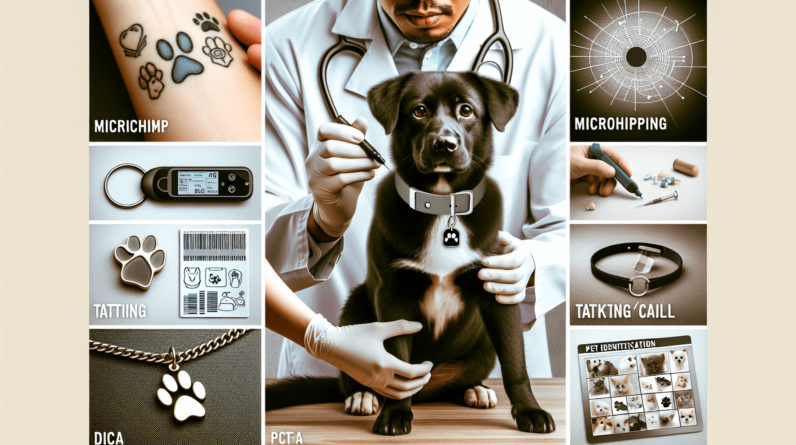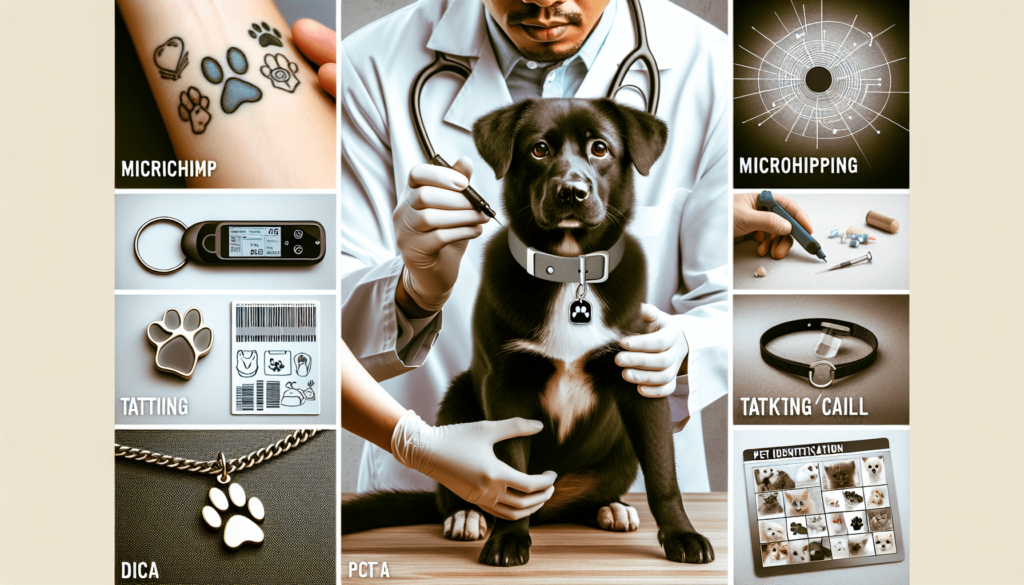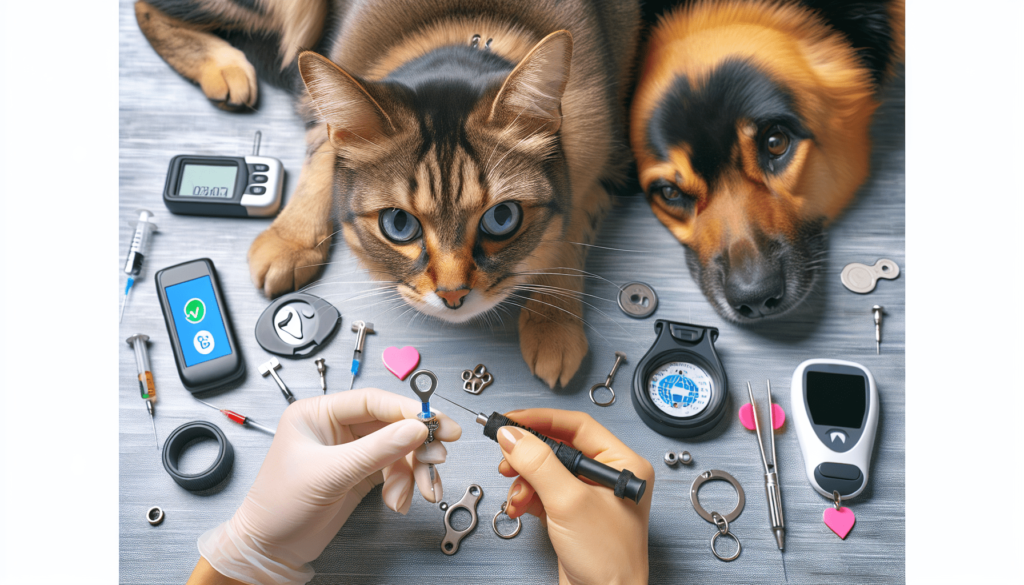
Are you curious about how to identify your beloved pet? Whether you have a dog, cat, or even a rabbit, it’s important to know the best ways to distinguish your furry friend. In this article, we will explore different strategies for identifying your pet, from microchipping and ID tags to distinctive markings and collars. By learning these techniques, you can ensure the safety and security of your pet, while also promoting responsible pet ownership in your community. So, let’s dive in and discover how you can easily identify your precious companion!

Physical appearance
Fur color and pattern
One of the easiest ways to identify your pet is through its fur color and pattern. Take note of the colors present in your pet’s fur, whether they are solid, striped, or spotted. The pattern can be a crucial identifying characteristic, especially if it is unique or distinct. For example, if your dog has a white stripe running down its back or your cat has a tabby pattern with swirls, these markings can help you identify them if they go missing.
Size and weight
Knowing your pet’s size and weight is another important aspect of identification. Take note of their measurements, such as their height, length, and weight. This information can be helpful in differentiating your pet from others, especially if you have a small or large breed. It can also assist in estimating their age, as many animals grow rapidly during their early years.
Unique markings or features
Look for any unique markings or features that make your pet easily recognizable. These can be anything from a specific spot on their fur, a birthmark, or even a missing limb. Unusual characteristics like these can greatly aid in identifying your pet, particularly if they have been lost or stolen. Take note of these distinctive traits so that you can provide accurate descriptions when looking for them.
Collar and ID tags
Attach a collar with ID tags
One of the most common and effective ways to identify your pet is by attaching a collar with ID tags. These tags typically include your pet’s name and your contact information, such as your phone number or address. When someone finds your pet, they can easily contact you and return them to safety. Ensure that the collar is properly fitted and comfortable for your pet to wear.
Include pet’s name and owner’s contact information
When choosing what information to include on your pet’s ID tags, make sure to include their name and your contact information. This way, if your pet gets lost, whoever finds them will have a way to get in touch with you promptly. Remember to provide an up-to-date phone number and consider including an alternative contact, such as a trusted friend or family member, in case you are not available.
Update information regularly
It is essential to update your pet’s ID tags regularly. In the event that you change your phone number, move to a new address, or even adopt a new pet, ensure that you update the contact information on your pet’s collar. This will maintain the effectiveness of the identification method and increase the likelihood of a successful reunion if your pet ever goes missing.
Microchipping
Implanting a small microchip under pet’s skin
Microchipping is a more permanent and secure method of pet identification. It involves a small microchip, about the size of a grain of rice, being implanted under your pet’s skin. The procedure is relatively quick and painless, and is typically done by a veterinarian. The microchip contains a unique identification code that is linked to your contact information in a database.
Unique identification code linked to owner’s information
Each microchip has a unique identification code that is registered to your pet’s information, including your contact details. If your pet is found and taken to a veterinarian, shelter, or animal control facility, they can scan the microchip to retrieve your information. It is crucial to keep your contact details up to date in the microchip database to ensure a successful reunion with your pet.
Scan at vet clinics, shelters, or animal control facilities
Microchips can be scanned at various locations such as veterinary clinics, shelters, or animal control facilities. If someone finds your pet and brings them to one of these places, the staff will scan for a microchip to see if your pet is registered. If your information is linked to the microchip, you can be quickly reunited with your beloved companion.
Tattooing
Permanent identification mark on the inner thigh or ear
Tattooing is another method of permanent pet identification, commonly used for livestock or show animals. It involves the application of a permanent mark, usually on the inner thigh or ear of the animal. The tattoo can be a combination of letters, numbers, or symbols that uniquely identify your pet. This method can be easily visible and provides a form of identification that cannot be lost or misplaced.
Registered with a tattoo registry database
To ensure the effectiveness of tattooing as a method of identification, it is essential to register your pet’s tattoo with a tattoo registry database. This registry will store the unique tattoo identification code along with your contact information. If your pet goes missing and is found, the tattoo can assist in tracing them back to you through the registered database.
Commonly used for livestock or show animals
Tattooing is particularly common among livestock or show animals where visual identification is crucial. It allows breeders, owners, and organizations to keep accurate records and trace the lineage of animals. While it is less common for companion animals, tattooing can still be considered as an option for additional identification, especially if you have a specific breed that may benefit from this method.

Photographs
Take clear photos of your pet
Taking clear and high-quality photographs of your pet can be extremely helpful for identification purposes. Make sure the images capture your pet’s face, body, and any unique markings or features. Use natural lighting and a steady hand to ensure the photos are sharp and clear. Having recent and accurate photos on hand can greatly assist in searching for your pet if they become lost or are stolen.
Capture unique distinguishing features
When photographing your pet, pay close attention to capturing any unique distinguishing features. This can include unusual coat patterns, distinct eye colors, or any scars or birthmarks. These features can serve as crucial identifiers when seeking to locate your pet. Additionally, close-up shots of any distinct markings will greatly aid in providing accurate descriptions to others who may be helping in the search.
Keep updated photos in case of loss or theft
It is important to regularly update the photographs of your pet as they grow and change. If your pet ever becomes lost or is stolen, having recent images will be invaluable in sharing accurate information with others, such as posting on social media or creating flyers. Remember to also keep printed copies of your pet’s photos in a safe place, as digital files can be susceptible to loss or technological issues.
DNA testing
Genetic testing to identify breed heritage
DNA testing is not only a popular trend among humans but also for pets. Genetic testing can provide valuable information about your pet’s breed heritage, helping to identify their ancestry. While identifying breed heritage may not directly lead to locating a lost pet, it can still provide crucial information when combined with other identifying features. Understanding your pet’s breed makeup can assist in creating accurate descriptions and alerts if your pet goes missing.
Can provide valuable information for identification
DNA testing can also provide valuable information beyond breed heritage. Genetic tests can uncover potential health issues or behavior traits associated with certain breeds. This information can be helpful for identifying your pet correctly, especially if they have a distinct health condition or behavioral characteristic. By understanding your pet’s genetic makeup, you can provide accurate information to others who may have found them.
Consult a veterinarian or use at-home DNA kits
To conduct DNA testing for your pet, consult with your veterinarian or use at-home DNA kits available on the market. Both options have their advantages and disadvantages. A veterinarian’s expertise can provide more comprehensive insight into the results, while at-home kits allow for convenience and privacy. Regardless of the method chosen, DNA testing can be a fascinating tool in identifying your pet and understanding their unique traits.
Behavioral traits
Observe and document unique behaviors
Every pet has its own distinctive behaviors and mannerisms. By observing and documenting these unique traits, you can assist in identifying your pet if they ever go missing. Does your dog have a specific way of wagging their tail? Does your cat have a particular meow or purr? These behavioral traits can play a crucial role in recognizing your pet and distinguishing them from others.
Note any specific habits or mannerisms
In addition to general behaviors, take note of any specific habits or mannerisms your pet may have. For example, does your dog have a favorite toy or a specific way of asking for treats? Does your cat have a routine for grooming or napping? These individual habits can serve as another layer of identification, as they may not be exhibited by other pets. In the event of loss or theft, sharing these unique habits can help others recognize and verify your pet’s identity.
Can aid in identifying your pet if lost
If your pet goes missing, sharing their unique behaviors, habits, or mannerisms can greatly aid in the identification process. When alerting your community or posting information online, be sure to mention any distinct behaviors that your pet may exhibit. This additional detail can assist others who may have seen or found your pet to confidently confirm the identity and increase the chances of a successful reunion.
Voice recognition
Record your pet’s vocalizations
Recording your pet’s vocalizations can be an innovative and fun way to aid in identification. By capturing their barks, meows, purrs, or other sounds they make, you can create a sound profile that is unique to your pet. This recording can be valuable in scenarios where visuals are insufficient, such as phone inquiries or when your pet may be found by someone who cannot physically see them.
Use voice recognition software or apps
To utilize voice recognition for pet identification, there are various software applications and smartphone apps available. These tools can analyze and compare the recorded vocalizations with your pet’s unique sound profile. If your pet goes missing and someone finds them, playing the recorded sounds can help confirm their identity. Remember to keep the recording updated as your pet’s vocalizations may change as they age.
Helps distinguish your pet from others
Just like humans, pets have their own distinct voices and sounds. By utilizing voice recognition methods, you can help differentiate your pet from others. This can be especially useful if your pet is in a crowded environment, such as a shelter or rescue center, where visual identification may be more challenging. Voice recognition technology can aid in reuniting you with your pet by providing an additional layer of confidence in confirming their identity.
Training and commands
Teach your pet specific commands
Training your pet to respond to specific commands is a practical way to confirm their identity. By teaching your pet basic commands like “sit,” “stay,” or “come,” you can create a unique set of trained responses. These commands can be helpful if your pet is found by someone else, as a trained response will provide a recognizable connection between you and your pet.
Use unique cues or words
To further personalize your pet’s training, consider using unique cues or words that are not commonly used by other pet owners. For example, instead of using the word “sit,” you could choose a different word like “park” or “chill.” By using distinctive cues or words, you can easily ascertain if your pet has been properly trained and increase the likelihood of successful identification.
Confirm identity through trained responses
Trained responses can serve as a reliable method of confirming your pet’s identity. If your pet is found or recovered, ask those who have found them to give the specific command or cue that your pet is trained to respond to. If your pet obeys correctly, this confirms that they are indeed your pet. This method is particularly effective for dogs, but it can also apply to other trainable pets.
Registration and licensing
Comply with local regulations for pet registration
To ensure proper identification and compliance with local laws, it is important to register your pet with the appropriate authorities. Different regions may have specific requirements for pet registration, including providing essential information such as your contact details and description of your pet. By complying with these regulations, you can have a legally recognized proof of ownership and identification.
Receive a unique identification number or tag
When registering your pet, you will typically receive a unique identification number or tag. This serves as a registration number that is linked to your pet’s information in the authorities’ database. The identification number or tag can be useful in proving ownership and accurately identifying your pet if they are lost or stolen. In some regions, the tag may be required to be visible on your pet’s collar at all times.
Helps in proving ownership
Registration and licensing are instrumental in proving your ownership of a pet. In the unfortunate event that your pet becomes lost, stolen, or involved in any legal disputes, having proper registration and licensing in place can help in providing evidence of ownership. It is important to keep the registration documents and identification tags in a safe place, readily accessible in case they are needed.
By utilizing the various methods and techniques outlined in this article, you can enhance your ability to identify your pet if they ever go missing. Remember to be proactive in implementing these identification measures and regularly update the information to maximize their effectiveness. Being prepared and equipped with accurate identification details will significantly increase the chances of a swift reunion with your beloved companion.







